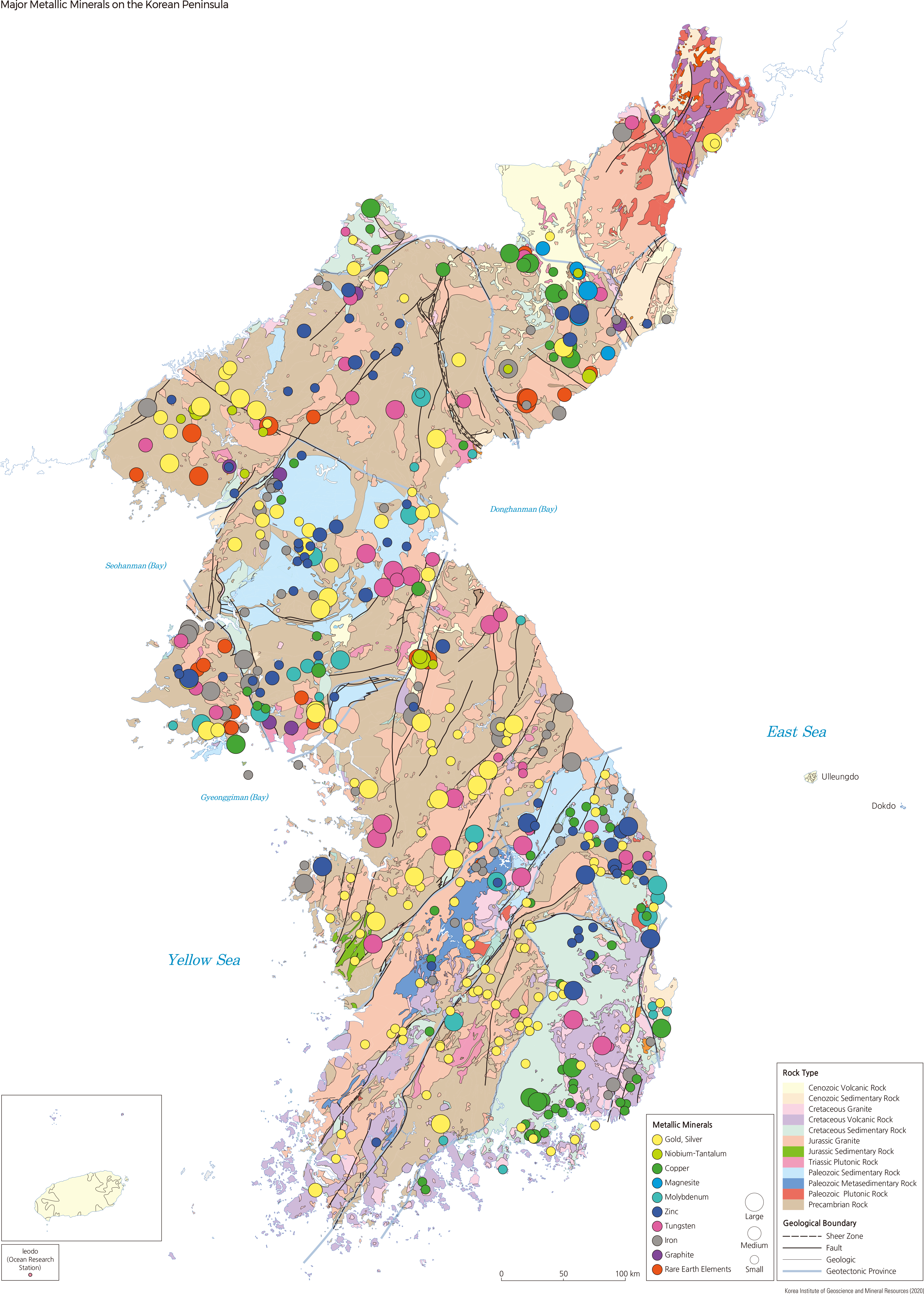English II 2020
The main mineral resources on the Korean Peninsula are metal, nonmetal minerals, placer, fossil fuel, nuclear fuel, and building stone/aggregate. Proterozoic ore deposits in the southern region of the Korean Peninsula include the banded iron formation in Seosan; the titanium-bearing-iron deposit in Gonamsan-Soyeonpyeongdo-Boleumdo; the Tungsten, tin, and gold deposits in Bonghwa-Uljin- Sangdong; ilmenite deposits in Hadong-Sancheong; the iron deposits in the Chungju-Jungwon; and the uranium deposits in the Ogcheon Supergroup.
Proterozoic ore deposits in the southern region of the Korean Peninsula include the banded iron formation in Seosan; the titanium-iron bearing deposit in Gonamsan(Yeoncheon)-Soyeonpyeongdo- Boleumdo; the tungsten, tin, and gold deposits in Bonghwa-Uljin-Sangdong; ilmenite deposits in Hadong-Sancheong; the iron deposits in the Chungju-Jungwon; and the uranium deposits in the Ogcheon Supergroup. In the northern region of the Korean Peninsula, a banded iron formation developed in the Musan and Oryong mines of the Archean Musan Group. Proterozoic ore deposits include the copper deposits in the Hyesan Youth and Gabsan mines, lead-zinc mine in Geomdeok and magnesite mines in Ryongyang and Daeheung. REE (rare earth elements) deposit related to the Protozoic Sakju Complex in Jeongju was reported as a world-class deposits.
Anthracite is embedded in the late Paleozoic Pyeongan Supergroup and middle Mesozoic Daedong Supergroup. In the southern region of the Korean Peninsula, the mining regions for Paleozoic anthracite are Samcheok, Gangneung, Jeongseon, Pyeongchang, Yeongwol, Danyang, Mungyeong, Boeun, and Boseong, and mining regions for Mesozoic anthracite are Boryeong, Buyeo, Kimpo, and Yeoncheon. In the northern region of the Korean Peninsula, anthracite is concentrated in Pyeongannam-do, and also a number of coal mines are being developed in Hamgyeongbuk-do and Hamgyeongnam-do. Uranium deposits are mainly distributed in Pyeongsan, Suncheon, and Bakcheon. These deposits seem to have developed in connection with the development of anthracite. The Hoam, Bumbuk, and Sinseong Niobium-tantalum deposits, which is related to alkaline intrusive rocks in the late Paleozoic and early Mesozoic, are in the Pyeonggang area.
The Mesozoic mine includes Jurassic pegmatite ore deposits in the Gyeonggi Massif, which includes feldspar, columbite-tantalite, molybdenite, fluorite, uranium-bearing minerals, and beryl. The Jurassic and Cretaceous gold and/or silver mines are mostly hydrothermal vein type. Representative gold and/or silver mines are located in Mugeug, Bupyeong, Imcheon, Weolyu, Jeonjuil, Tongyeong, and Geochang. Tungsten-molybdenite also formed near Mesozoic granites during the Jurassic and Cretaceous. Copper, lead, and zinc deposits were formed by hydrothermal alteration related to the Cretaceous igneous activity. Cretaceous iron mines are located in the Gyeongsang Basin. Talc deposits formed by hydrothermal metasomatism are classified into two types: one type is of ultramafic origin and can be found in the Pyeongan and Cheongdang mines and the other type is of dolomite origin and can be found in the Dongyang, Pungjeon, and Chungju-Jaeil mines. The kaolinite-pyrophyllite deposits were formed by hydrothermal alteration of tuff, felsite, and andesite and are distributed in the Miryang-Yangsan-Changwon-Tongyeong region and the Jindo-Wando-Haenam-Yeongam region.
In the northern region of the Korean Peninsula, the mines related to Mesozoic igneous activity occur as skarn and vein-type deposits associated with various mineral resources, including gold. Representative gold and silver deposits can be found in the Unsan mine, the Daeyubong mine, the Seoncheon mine, the Holdong mine, the Suan mine, and the Rakyeon mine. Tungsten deposits are found in the Mannyeon mine, the Yangdeuk mine, the Jangjin mine, and the Beobdong and Goseong mines. Molybdenite mines include Ryonghong and Sakju mines and Gamuri and Yangam mines.
In the southern region of the Korean Peninsula, Cenozoic deposits can be found in the Wondong mine, the Dongjeom mine, and the Geumryeong mine. The mines contain skarn and porphyry type deposits, including various metals. The zeolite, bentonite, and acidic bentonite occur along the tuff stratigraphic horizon within the Tertiary sedimentary formations around the Pohang-Guryongpo-Ulsan. |



